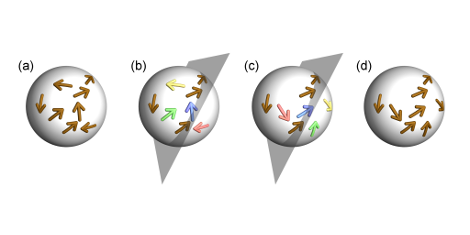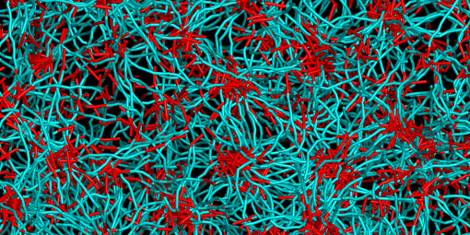The Luijten research group focuses on a broad range of phenomena occurring in “soft matter” systems, which include polymeric and colloidal materials, solutions in which different components aggregate into complex structures, biomedical and biological systems, and so on. The common thread unifying these themes is that they are investigated via particle-based computer simulations, with an emphasis on understanding rather than just quantifying the mechanisms at play. Since these problems are often computationally very demanding, we also actively work on the development of new algorithms.
Colloidal systems

Colloids, particles ranging in size from a few nanometers to several micrometers, are a very important component of many materials that we encounter in our daily lives: cosmetics and healthcare products, food, biological and biotechnological systems, ceramics. Moreover, larger colloids (upward of 200 nm) are very suitable for studying physical phenomena that are described by equilibrium and nonequilibrium statistical mechanics. Their size makes them accessible by video microscopy, their typical interactions strength is strong enough to be relevant, but not so strong that all collective behavior is dominated by irreversible aggregation, and their typical time scale of motion leads to aggregation phenomena that often take place over the range of seconds to hours. We closely collaborate with experimental research groups, especially the group headed by Professor Steve Granick at UIUC, to investigate a wide range of properties of colloidal suspensions. A particular area of expertise are so-called Janus particles.
Electrostatically driven self-assembly

Many biological and synthetic systems are comprised of charged components, and electrostatic interactions play an important role in their aggregation behavior. In particular, multivalent ions or small molecules can induce effective attractions between polyelectrolytes. We pursue an active research program that examines and exploits the phenomena associated with multivalent "linkers." An example is DNA condensation, the aggregation and subsequent precipitation of DNA in solution. In collaboration with the research group of Professor Hai-Quan Mao at Johns Hopkins University we exploit this condensation process to create different types of nanoparticles comprised of a polymeric shell that encapsulates plasmid DNA, resulting in carriers with properties that make them highly suitable for gene delivery purposes.
Algorithm development

Many of the collective phenomena we investigate require the simulation of large systems that must be followed for long times. For this reason, we are actively working on new algorithms that accelerate the calculations and bring new systems within reach. A notable highlight is the Geometric Cluster Algorithm, a rejection-free Monte Carlo algorithm that greatly accelerates the simulation of large classes of complex fluids. In recent work, we have generalized this methodology to anisotropic building blocks and applied it to highlight the flexibility and convenience offered by multicomponent systems in the design of self-assembling systems. Current work focuses on methods that allow the explicit calculation of electric polarization charges (dielectric materials) and on simulations that incorporate hydrodynamic effects.
Polymeric materials

Polymers constitute the building blocks for a wide range of materials, which can take many different forms—from solutions and gels to crystalline solids. In addition to the study of charged polymers (polyelectrolytes), which are particularly important in the field of electrostatically driven self-assembly, our current work focuses on polymer dynamics, including diffusion in polymeric media and the effect of hydrodynamic interactions on polymer conformations.

